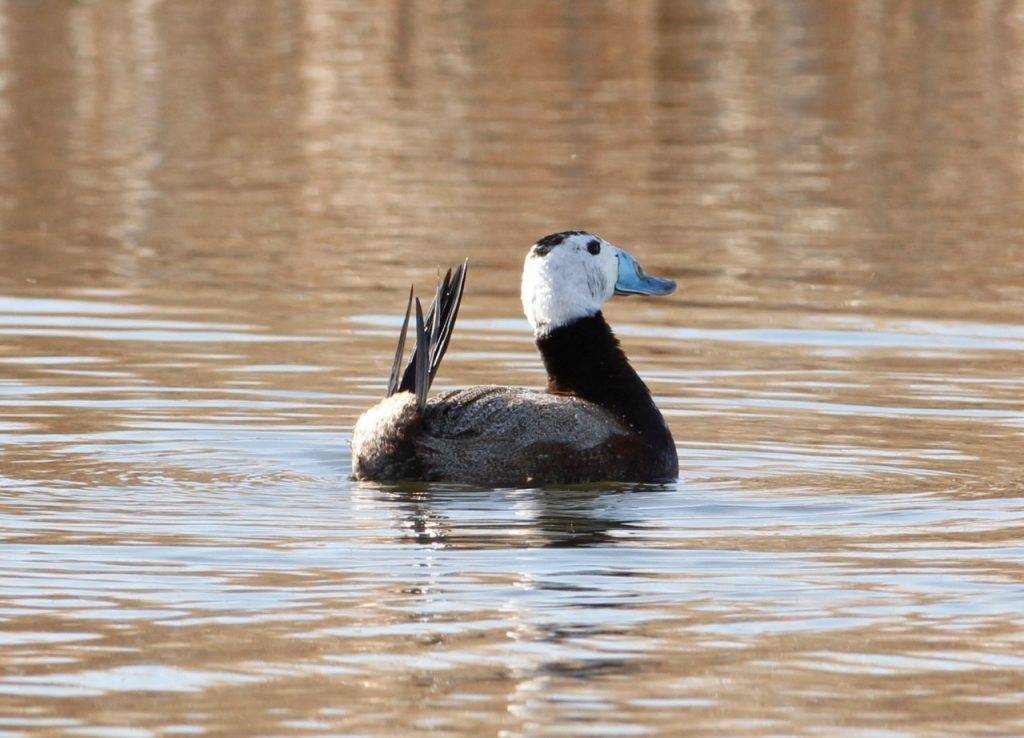In 2012, OSME’s Conservation and Research Fund provided The Association for the Conservation of Biodiversity of Kazakhstan (ACBK) funding to initiate a study of the endangered White–headed Duck in central Kazakhstan. As well as receiving funding from OSME, the project leader Alyona Shmolenko also secured the financial support of the Conservation Leadership Programme.

The White-headed Duck (Oxyura leucocephala) is a small diving duck with rather unusual appearance. The bird’s rarity and distinctive features provided the inspiration for the ACBK logo and have made it a must-see for international birdwatchers visiting Kazakhstan. Its features are easily recognisable, a bill with a swollen base, a white head and a tail cocked vertically on water. The adult male is particularly striking with a blue beak and white head topped with a black cap. Like many other duck species, the female has a far more modest plumage.
White-headed Ducks have a fragmented distribution stretching from Spain and North Africa, through Turkey and into the steppes of Central Asia and an isolated population in Pakistan. According to the latest estimates, the global population of White-headed Duck is around 8,000 – 13,000 birds (Li & Mundkur, 2003), with the largest population found in Central Asia. The distribution, breeding ecology and key threats in Kazakhstan are poorly known, despite holding the bulk of the Central Asian population.
The goal of the project was to gather new data on the conservation status of White-headed Duck in Kazakhstan and update the National Single Species Action Plan.
In July 2013, two groups of ornithologists began work exploring the habitat of the White-headed Duck at two of the key nesting sites in Kazakhstan – the lakes in the Kostanay province and the Tengiz-Korgalzhyn Lake System. The White-headed Duck chooses nesting sites that are difficult to access, such as lakes lined with dense vegetation, reed-covered inlets and ditches. Most of these sites are not easy to observe from dry land so monitoring has to be done by boat. This was the main challenge facing the project team in the Korgalzhyn State Nature Reserve with its vast areas of boggy wetland. As a result, it was only possible to explore a small fraction of the habitat suitable for nesting sites.
Despite the logistical difficulties, the project team documented 45 lakes where the White-headed Duck have been recorded in the past and carried out detailed hydro-biological analyses at nine of these sites. More than 4,500 individuals were recorded during the season 2013 in Kazakhstan on migration. 95% of these birds were counted in the Tengiz-Korgalzhyn province. These data will eventually help us to determine which characteristics the birds are looking for when selecting nesting sites.
According to the results of the first year of monitoring and the data the project team have collected so far, the primary threats facing the White-headed Duck in the project area are disruption to water levels, poaching and being trapped in fishing nets.

White-headed duck entangled in a discarded fishing net
In 2014 the monitoring area was enlarged to one more region – North-Kazakhstan Oblast. Thanks to the participation of student birdwatching clubs, 3 more important migrating areas were identified. At the same time in the Korgalzhyn region, a record number of migrating WHDs was counted – more than 6000 birds.
The results of the first two years of ACBK’s White-headed Duck have been encouraging, but it is important to stress that there are still many aspects of the birds breeding biology that need further study. As well as understanding breeding ecology we also need to initiate research on the migration behaviour of the species.
The ACBK project team are grateful to OSME for their support for this project through the Conservation and Research Fund.
Alyona Shmalenko
ACBK, White-headed Duck project leader.
Additional note. OSME Council have been impressed with the work undertaken so far, and will be posting a further update soon
Rob Sheldon, OSME Chairman
